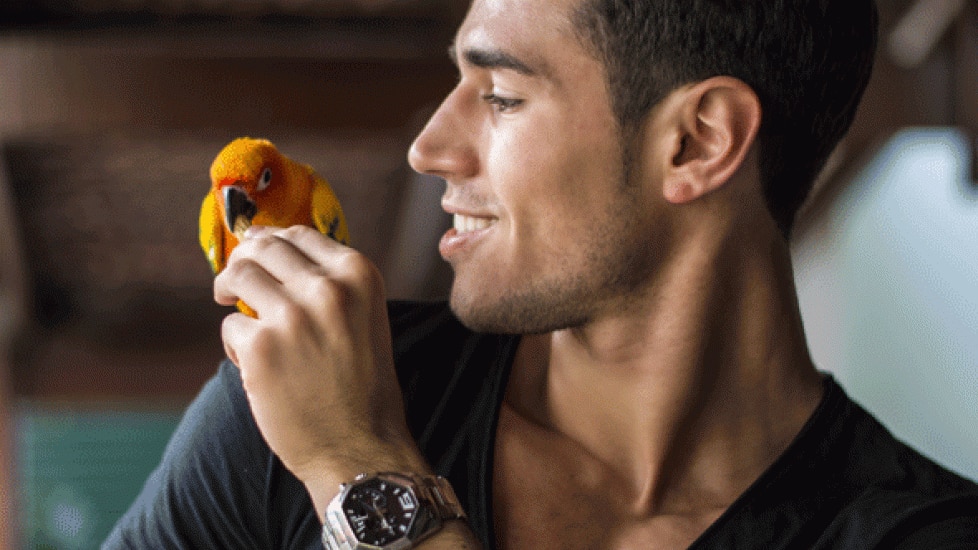How to Shoulder Train Your Bird
by Vanessa Voltolina LaBue
Whether you’re an enthusiast or a newbie to the avian world, you likely know the fun in letting your bird hang around outside of its cage. However, letting your flying friend out requires some training and boundaries—for both bird and owner!
Many owners ask about the best way to teach a bird to sit on their shoulder and behave while it’s there. Here, we have the experts weigh in on the dos and don’ts of working with your bird out of its cage.
Should I shoulder-train my bird?
“Most avian experts agree that sitting on a shoulder is not the best option for most birds,” said Jacqueline Johnson, manager of the Parrot Garden at Best Friends Animal Society in Kanab, Utah. She mentions Netherlands-based avian behaviorist Dr. Jan Hooimeijer, who believes that allowing birds on a shoulder may foster insecurity in the bird.
“Birds can be prone to redirection,” explained Johnson, “so if they are frightened, you can take a nasty face bite.” Another reason, she says, is that unless a bird is exceptionally well-behaved and bonded, “it will play keep-away when you are trying to get it to step up from your shoulder.” Imagine how frustrating it would be to wrangle with your bird while it is hanging off the middle of your back—a common situation bird owners find themselves in.
So, “unless your bird will step-up immediately when asked, a shoulder is not recommended,” said Johnson.
Of Johnson’s seven birds that she personally owns, she said only two are allowed “shoulder privileges,” as she calls it.
How can I train my bird outside of the cage?
Instead of shoulder training, Johnson and her team strongly suggest people teach their birds to step-up onto a hand—and stay there. “If you hold your arm perpendicular to the floor, with your elbow tucked into your side,” she explained, “it makes it easy to keep a bird from running up your arm to your shoulder.”
The first method for achieving a hand “step-up”—if your bird doesn’t already understand this command—is to convince the bird to take a treat from your hand, explained Johnson. “I recommend finding [your bird’s] very favorite treat and using that for training sessions.”
“Then, over time, you convince the bird to step up on the opposite arm to get the treat, by holding the treat over your arm and luring it,” she said. It doesn't take long to teach a bird, “because of their high degree of intelligence and reasoning skills,” she added.
Johnson recommends only positive reinforcement be used for training, “or you can irreparably damage your relationship [with your bird].”
Watch your bird’s body language
As with training any animal, keeping a close eye on your feathered friend’s body language is key. “Birds do a lot of their communicating via body language,” explained Johnson. “In fact, one of the main causes of bird bites is a failure to pay attention to what your bird is telling you,” she added.
While each species has differences, there are some general signs that your bird has had enough. “Almost all [birds] will lean towards the cage and start acting like they are trying to get the courage to fly back to it,” said Johnson. This may include flicking their wings at the shoulder (like a fast shrugging motion), she said.
“If you immediately take the bird back [to its cage] when you see this behavior, it will help teach [your bird] that you understand, and that it’s safe with you,” she said.
What are the risks of shoulder or hand-training a bird?
The reason Johnson and her team recommend hand training versus shoulder training is due to the known risks.
Birds are prey species; when startled—be it by a loud noise or sudden movement—they are hardwired to flee first, said Johnson. This could be detrimental for your bird, especially if it has the freedom to fly around the house, since it can escape the safe confines of home through an open door or window. Many birds are lost every year in this way.
Even the most mentally well-balanced bird can startle and panic, and clipped wings are no guarantee of safety, she added. “Even if a bird's wings have been clipped, it can fly, to a certain extent,” she explained. In addition, she said, even trained birds should not be taken outside while perched on your arm. “We recommend never taking your bird outside unless it is in a carrier or wearing a bird harness,” said Johnson.
Apart from the risk to your bird, there is also the risk to your own body. “Birds can be curious,” which means they may pull your hair, bite your ears, and chew or tug on your jewelry, said Johnson. She suggests making bird-friendly jewelry to wear around your neck for when your bird is sitting with you — birdie necklaces strung with bird-safe toys on a bird-safe chain or rope for the bird to play with.
And, of course, while not life endangering, there is also the possibility that your bird will poop on your shoulder, ruining your favorite shirt! If you do allow your bird to hang out on your shoulder, a “poop cloth” (aka a shoulder cape, available from many pet supplies) draped over your shoulder is highly advised.
This article was verified and edited for accuracy by Dr. Laurie Hess, DVM, Diplomate ABVP
